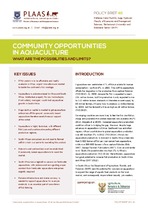Community opportunities in aquaculture, What are the possibilities and limits?
Abstract
Aquaculture now contributes 47% of fish available for human
consumption – up from 9% in 1980. This shift to aquaculture
offsets the stagnation in the production from capture fisheries
(FAO 2012). By 2030, demand for fish is expected to reach
261 million tonnes, but fish production is only expected to rise
to 210 million tonnes; demand will therefore exceed supply by
50 million tonnes. Africa is likely to produce 11 million tonnes
by 2030, but the demand will be as high as 18 million tonnes
(FAO 2013).
Developing countries are more likely to feel the fish shortfall as
cheap and accessible fish protein becomes less available (HLPE
2014; Delgado et al 2003). Increased aquaculture production
could be critical in bridging the gap. However, despite huge
advances in aquaculture in China, Southeast Asia and other
regions, Africa’s contribution to global aquaculture production
was still less than 3% in 2012 (FAO 2014). Africa’s low
aquaculture productivity is mirrored in South Africa where less
than 5 000 tonnes of fish per year comes from aquaculture,
while over 600 000 tonnes is from capture fisheries (Britz
2007; George Warman Publications 2007). Even at continental
level, South Africa contributes less than 1% to Africa’s
aquaculture production (FAO 2014). Nevertheless, aquaculture
has great potential to increase fish production in South Africa
and Africa (DAFF 2012).

